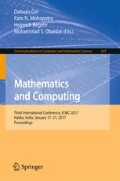Abstract
Cellular automata (CA) is universally known as very good pseudorandom sequence generator. It has wide applications in several fields like VLSI design, error-correcting codes, test pattern generation, cryptography etc. Most of these applications use 3-neighborhood one dimensional CA. Cellular automata have been chosen as a better crypto-primitives for providing very good pseudorandom sequences and their high diffusion property. The randomness and diffusion properties can be increased with the increase of the size of neighborhood radius of the CA cell. In this work, we study a class of 5-neighborhood null boundary linear CA. We present an algorithm for synthesizing 5-neighborhood linear CA from its characteristic polynomial by assuming that some of the CA sub-polynomials are available.
Access this chapter
Tax calculation will be finalised at checkout
Purchases are for personal use only
References
NIST SP 800-22: A Statistical Test Suite for Random and Pseudorandom Number Generators for Cryptographic Applications. U.S. Department of Commerce (2010)
Bardell, P.H.: Analysis of cellular automata used as pseudorandom pattern generators. In: Proceedings IEEE International Test Conference 1990, Washington, D.C., USA, 10–14 September 1990, pp. 762–768 (1990)
Bouganim, L., Guo, Y.: Database Encryption in Encyclopedia of Cryptography and Security, 2nd edn. Springer, New York (2010)
Chaudhuri, P.P., Roy Chowdhury, D., Nandi, S., Chattopadhyay, S.: Additive Cellular Automata: Theory and Applications. IEEE Computer Socity Press, New York (1997)
la Guaz-Martinez, D., Fuster-Sabater, A.: Cryptographic design based on cellular automata In: Proceedings of IEEE International Symposium on Information Theory, p. 180 (1997)
Ikenaga, T., Ogura, T.: Real-time morphology processing using highly parallel 2-D cellular automata. IEEE Trans. Image Process. 9(12), 2018–2026 (2000)
Jose, J., Roy Chowdhury, D.: Four neighbourhood cellular automata as better cryptographic primitives. IACR Cryptology ePrint Archive 2015, 700 (2015)
Kumar, K.J.J., Sudharsan, S., Karthick, V.: FPGA implementation of cellular automata based stream cipher: Yugam-128. IJAREEIE 3 (2014)
Tomassini, M., Sipper, M., Perrenoud, M.: On the generation of high-quality random numbers by two-dimensional cellular automata. IEEE Trans. Comput. 49, 1146–1151 (2000)
Matsumoto, M.: Simple cellular automata as pseudorandom m-sequence generators for built-in self-test. ACM Trans. Model. Comput. Simul. 8(1), 31–42 (1998)
Nandi, S., Kar, B.K., Chaudhuri, P.P.: Theory and applications of cellular automata in cryptography. IEEE Trans. Comput. 43(12), 1346–1357 (1994)
Neumann, J.V.: The Theory of Self- Reproducing Automata. University of Illinois Press Urbana (1966). (Edited by Burks, A.W.)
Roy Chowdhury, D., Sengupta, I., Chaudhuri, P.P.: A class of two-dimensional cellular automata and their applications in random pattern testing. J. Electron. Test. 5(1), 67–82 (1994)
Sudhakar, P., Chinnarao, B., Latha, D.M.M.: Optimization of 1D and 2D cellular automata for pseudo random number generator. IOSR J. VLSI Sig. Proc. (IOSR-JVSP) 4, 28–33 (2014)
Wolfram, S.: Theory and Applications of Cellular Automata (Including Selected Papers 1983–1986). World Scientific Pub. Co., Inc., River Edge (1986)
Author information
Authors and Affiliations
Corresponding authors
Editor information
Editors and Affiliations
Rights and permissions
Copyright information
© 2017 Springer Nature Singapore Pte Ltd.
About this paper
Cite this paper
Maiti, S., Roy Chowdhury, D. (2017). Study of Five-Neighborhood Linear Hybrid Cellular Automata and Their Synthesis. In: Giri, D., Mohapatra, R., Begehr, H., Obaidat, M. (eds) Mathematics and Computing. ICMC 2017. Communications in Computer and Information Science, vol 655. Springer, Singapore. https://doi.org/10.1007/978-981-10-4642-1_7
Download citation
DOI: https://doi.org/10.1007/978-981-10-4642-1_7
Published:
Publisher Name: Springer, Singapore
Print ISBN: 978-981-10-4641-4
Online ISBN: 978-981-10-4642-1
eBook Packages: Computer ScienceComputer Science (R0)

